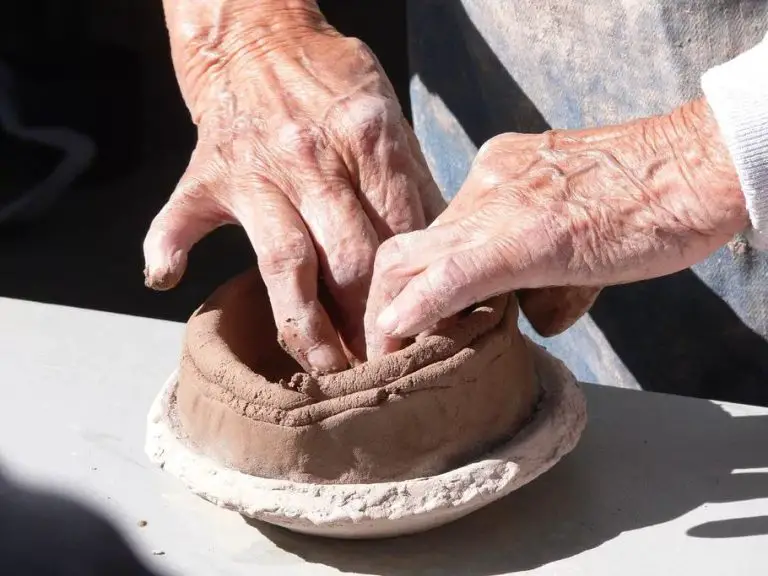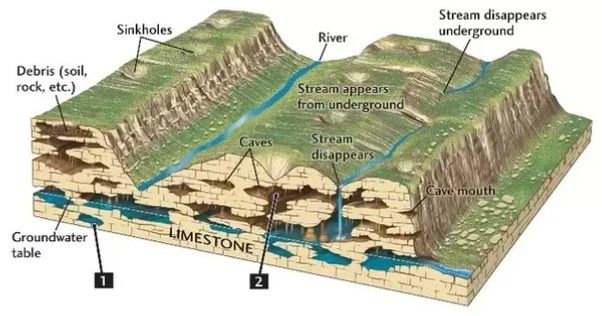What Is Clay Mixed With Water Called?
Clay is a type of fine-grained natural soil material that is plastic when wet, yet hardens when dried or fired. Clays are composed primarily of minerals like silica, alumina, and water. They are an important resource utilized in ceramics, construction, and industrial applications.
Clays exhibit plasticity when mixed with water, meaning they can be molded into shapes that retain their form. This is due to the plate-shaped structure of clay particles and their chemical interactions with water. When wet, the plates slide over one another easily as the clay is shaped. When the clay dries or is fired, the plates lock together in a rigid matrix, fixing the formed shape.
The types of clays can be categorized by their mineral content. Kaolinite clay contains mainly kaolinite minerals, while ball clays also include other mineral impurities that enhance plasticity. Fire clays have a high content of alumina and silica, enabling them to withstand high firing temperatures. Clays are an abundant, diverse material utilized for making pottery, bricks, ceramics, cement, and more.
Clay and Water
When clay is mixed with water, a chemical reaction takes place between the clay particles and water molecules. Clay has a layered structure, with tiny spaces between each layer where water can penetrate. When water is added to clay, the water molecules are absorbed into these spaces, causing the clay to soften and become more malleable or “plastic.”
The absorption of water acts to separate the clay layers from each other, allowing them to slide over one another more easily. This gives clay its unique “plastic” properties when wet, allowing it to be shaped or molded. The water molecules help to lubricate between the microscopic clay particles.
The amount of water absorption depends on the specific type of clay. Clays with smaller particles and more surface area tend to absorb more water. The ratio of water to clay required to reach an ideal plastic state also varies amongst clay types and is an important factor when mixing clay for pottery or sculpture.
Plasticity
One of the most important properties of clay is its plasticity or ability to be molded and shaped when mixed with water. Plasticity occurs because the clay particles are flat and microscopic, allowing them to slide over one another when wet. This gives clay a smooth, malleable texture that can be formed into different shapes.
The key to plasticity is water. Adding the right amount of water lubricates the clay particles so they can move around each other freely. Too much water will make the clay runny and impossible to shape. Too little water will make the clay crumbly and dry. An optimal amount of water allows the clay to become pliable, yet firm enough to hold its shape.
Clay’s plasticity allows it to be crafted into pottery, sculptures, bricks, and other useful objects. Once the clay is shaped and allowed to dry, the water evaporates and the clay hardens, retaining its formed shape. Firing the clay in a kiln further hardens it into a permanent ceramic material.
Plasticity is what distinguishes clay from other soils and enables its versatility for crafting and construction. This unique property has made clay an indispensable material throughout human history. Understanding the science behind plasticity allows potters and builders to skillfully utilize clay’s moldable nature.
Clay Slurry
Clay slurry refers to the mixture formed when clay is combined with water. It consists of clay particles suspended in water, creating a thick, smooth liquid substance. The water acts as a lubricant, allowing the clay particles to flow smoothly over one another. This gives the clay a soft, malleable, plastic-like consistency. The technical term for this effect is plasticity.
Clay naturally contains minerals that absorb water. When water is added, these minerals draw the water in, forcing the clay particles apart and allowing them to slide over one another. The more water that is added, the thinner and more fluid the clay slurry becomes. With less water, the slurry is thicker and more viscous.
The exact ratio of clay to water can be adjusted to achieve the desired consistency required for different applications. Clay slurry is used extensively in ceramic production, construction materials, drilling operations, and other industrial processes. The viscosity and properties of the slurry are tailored for each specific use case.
Uses
Clay slurry has a variety of uses across different industries and applications. Some of the most common uses include:
Pottery
In pottery, clay slurry is an essential material used to create ceramics and pottery. Potters mix clay and water to make a smooth, liquid slip that can be poured into molds or shaped by hand. The water content allows potters to shape and join pieces of clay together that would otherwise be too stiff to manipulate. Once shaped, the pieces are left to dry until the moisture evaporates, leaving behind the solid clay form.
Construction
Clay slurry has applications in construction as well. One example is its use in cob building, an ancient technique that utilizes clay, sand, straw, and water to create monolithic earthen structures. The clay and water are mixed together to create a sticky, pliable dough that is applied by hand in layers to build walls. As the clay dries, it hardens into a natural, durable building material.
Drilling
In the drilling industry, bentonite clay is mixed with water to create a heavy mud slurry. This drilling mud is pumped into drill holes and boreholes to lubricate the drilling process, maintain the integrity of the hole, and transport cuttings back to the surface. The viscosity and gel strength of the clay slurry allow it to suspend rock cuttings and prevent the hole from collapsing.
Clay Slip
A clay slip is a thin, liquid slurry made from clay mixed with water. It has a creamy, milkshake-like consistency that allows it to be poured and spread easily. Clay slip is made by mixing clay powder or dry clay with water until it reaches the desired viscosity. The specific properties and uses of a clay slip depend on the type of clay used and the ratio of clay to water.
Typically, clay slip contains higher amounts of clay relative to water compared to a clay slurry. This gives it a thicker, smoother texture that still flows easily. The consistency can range from that of heavy cream to as thick as latex paint. Clay slips are used for pouring into molds to create ceramic objects through slipcasting. They are also painted onto ceramic bisque ware as a base glaze before firing.
The clay particles dispersed in the water give clay slip its useful binding properties. As the water evaporates, the clay particles move closer together, increasing the strength of the dried or fired object. Using an appropriate clay body and mixing the ideal ratio of clay to water is important for creating a clay slip with the desired working qualities for different applications.
Casting Slip
Casting slip is a specific type of clay slurry that is used in the process of slipcasting. Slipcasting is a method of forming ceramic objects by pouring a liquid clay slurry into a plaster mold. As the slurry touches the mold, the water is drawn out through the porous plaster, leaving a layer of clay on the mold surface that forms the final object.
To make a good casting slip, the clay particles must be suspended in water at an optimal consistency. Too thin, and the slurry will not build up enough clay on the mold surface. Too thick, and it will trap air bubbles and be difficult to pour smoothly. The clay particles in casting slip are also refined to a very small, uniform size through sieving and sedimentation so they cast well.
The main considerations in formulating a casting slip are the clay-to-water ratio, particle size distribution, and viscosity. Clays high in silica like kaolin are commonly used. Deflocculants are added to break up clay particle clusters so the slip flows smoothly. A well-made casting slip will have a creamy consistency similar to heavy cream or yogurt.
Casting slip is an essential material for potters and ceramicists who use the slipcasting technique. The right formulation allows high quality greenware to be produced rapidly and consistently when casting multiple pieces from the same mold.
Clay Dough
Clay dough is a soft solid clay slurry made from clay and water. It refers to a malleable or plastic mixture with a thicker, dough-like consistency. Clay dough contains a higher percentage of clay relative to water, giving it more body and allowing it to hold its shape when molded.
The clay powder absorbs the water and binds together to form a pliable material that can be shaped, similar to playdough. The exact ratio of clay to water can vary, but generally has enough water for plasticity while minimizing excess moisture. Too much water results in a runny slip, while too little water produces a crumbly mixture.
Clay dough is used for handbuilding and sculpting clay artworks and pottery. It can be molded by hand into 3D forms, or rolled out and cut into shapes. The soft solid texture enables clay artists to manipulate the material into intricate designs without it dripping or running. Once shaped, clay dough can be dried and fired into ceramic pieces.
Clay Batter
Clay batter is a thinner version of clay slurry. It contains a higher ratio of water to clay, making it more fluid and pourable. Clay batter has a smooth, creamy consistency akin to pancake batter or cake batter. It can be easily poured into molds and shapes before drying and retains intricate details well.
Clay batter is useful when a very fluid clay mixture is needed for casting and molding. The high water content allows air bubbles to rise easily to the surface, minimizing pores and defects in finished pieces. Smooth, thin clay objects can be made by pouring clay batter into plaster molds and letting it dry. Clay batter flows smoothly over complex shapes and into fine detailing.
Artists and potters adjust the thickness of their clay batter depending on the characteristics needed. Thinner batter is great for detailed molds while thicker batter holds shapes better. The slipperiness and fluidity of clay batter makes it ideal for casting sculptures, tiles, plates and other objects with high precision and intricate shapes.
Conclusion
Clay is a versatile material that can be mixed with water to create different consistencies for a variety of purposes. Here’s a summary of the main terms for clay and water mixtures:
Clay Slurry – A thin, pourable mixture of clay and water used for slipcasting ceramics. Slurry has high water content.
Casting Slip – Another name for clay slurry used in slipcasting.
Clay Dough – A thick, moldable clay and water mixture. Clay dough has lower water content and can be shaped by hand.
Clay Batter – A smooth, creamy clay mixture used for pouring and coating. Clay batter has medium water content.
The amount of water mixed with the clay determines its plasticity and suitability for different applications in pottery, ceramics, and art. With an understanding of these common terms for clay and water combinations, ceramists can easily discuss and create their desired material.



